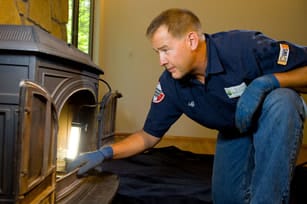Nobody wishes to pay extra and wait for appointed times to get their chimneys cleaned; as such, people have turned to other solutions that cost less or frees up their schedules for other activities. For lawn mowing, some pay for others to do it for them. For food transportation, instead of driving to pick up, some elect to pay extra for delivery. For chimney sweeps, this quick-fix solution takes the shape of chimney cleaning/sweeping logs; however, as it turns out, these logs, while valid, are not replacements for professionals. So how does the DIY solution match the professionals?
What are Chimney Cleaning Logs?
Chimney Cleaning Logs, aka Creosote Sweeping Logs, are unique logs meant to aid in cleaning Chimneys. They work by softening the layer of creosote, a group of chemicals formed when one burns plant-derived materials, formed inside and along the inner walls. The chemicals in the smoke of the log transition creosote from a thick grungy residue to a flaky and easy to scrape off layer.
Why does creosote need to be removed?
Creosote is a flammable material responsible for many if not most chimney fires; the reason it does not burn from the fire is escaping in the smoke before ignition temperature is met. If allowed to sit inside the flue of a chimney, however, it can be ignited. It is recommended that open masonry fireplaces be swept at 1/8″ of “sooty build-up” and even sooner if a glaze is present. This sooty build-up is creosote, and it must be cleared as that small amount is enough to cause a chimney fire capable of damaging the chimney and spreading to the home. Sooner even still for Factory-built fireplaces due to the deposit being acidic.
With the dangers of creosote in mind, it is reasonable for one to wish to purchase and use Chimney Sweeping Logs. However, during a routine chimney sweep, the sweeper does more than just creosote cleaning. Secondly, these logs only have displayed a recognizable effect on first-degree creosote build-up when it is little more than a thin layer of flakes. Once creosote has built up enough to look somewhat like tar or thick flakes, it is rendered ineffective. While one can get this off with some elbow grease, it is recommended to hire a chimney sweep to get rid of everything and inspect for any lasting damage. Lastly, there is third-degree creosote which resembles a thick glazed tar. It likely is thick enough to restrict the air output of the chimney and may have damaged the chimney liner; it is necessary to contact a professional chimney sweep at this stage.
Click here to learn more about creosote.
Should you use Chimney Cleaning Logs?
As a substitute, however, if used as directed, the logs may serve to aid the chimney sweep to do their job faster and work as a preventative measure for build-up. With them, brushing may prove helpful, especially if you often use your fireplace during the fall and winter seasons.
There is a worry in the fact that some chimneys do not have straight vertical flues. Some of the creosote can wind up trapped in the bends of said fireplaces, and as a reminder, it is highly flammable. With this, any stray spark may start a chimney fire. Such is only made more likely if it builds up and constricts the space.
To see more about chimney fires click here.
Despite mainly being helpful for chimney sweeps as it helps loosen the creosote and can shorten (and possibly cheaper) visits, it can lengthen the appointment instead. This is because loosened creosote can accumulate in the smoke shelf, a challenging to clean part of the chimney. In the end, they are too good to be true, but there is a chance they can make your life hard and not easier. Chimney Sweeping Logs cannot replace professional Chimney Sweeps and are best used instead as an aid.
Author: Tra’Lon Gillis

